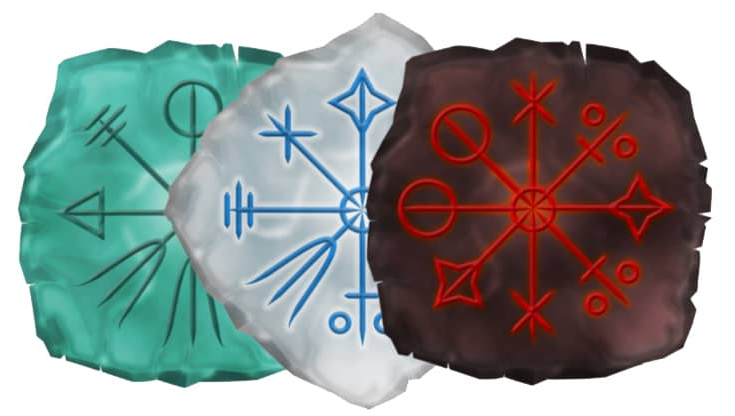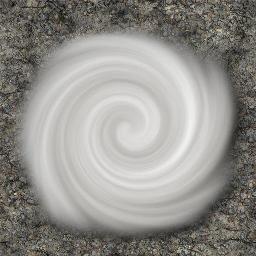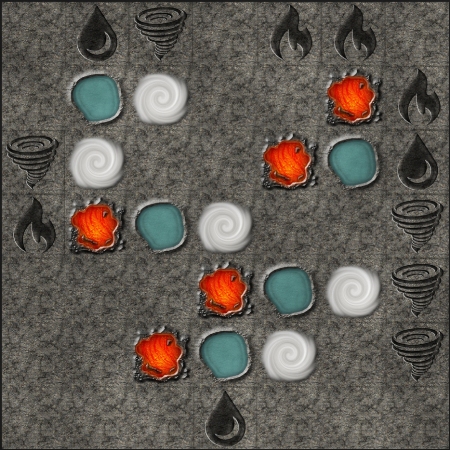Dungeons and Dragons uses the four elements – earth, air, fire, and water – throughout its books. There are elemental monsters, spells, and even elemental planes. So it makes perfect sense to have elemental puzzles in your D&D world as well.
In this article, we’ll look at two puzzles you can use to represent the four elements. There are:
- Runestone Puzzles
- Elemental Puzzles
They both have a very different approach to using elements in your game. So let’s dive right in.
Using Runestones to Create a D&D Earth, Air, Fire or Water Puzzle
The first elemental puzzle we recommend is Runestone Puzzles. This puzzle wasn’t specifically designed as an elemental puzzle but we are using it that way and it works very well in our opinion.
These puzzles come with three types of Runestones.
- Fire is represented by the black runestone.
- Air is represented by the white runestone.
- Water is represented by the green runestone.
- Earth is represented by the board on which these stones are placed.

That takes care of the elements but what about the runes on each stone? In Dungeons & Dragons there are four elemental languages:
- Terran for earth
- Aquan for water
- Ignan for fire
- Auran for air
These languages together form the primordial language family. The official D&D material gives no grammar of script for the languages so we are free to use the runes as the basic primordial script.
Now that each stone is given an element and the runes correspond with elemental languages, it’s time to look at the puzzle itself. How does it work?

Players can place the stones on the board (earth element) but the color of the runestone must match the color of the board. So a black firestone can only be placed on a black square and so on.
Each elemental runestone also has eight runes inscribed on it. Players need to rotate the runestones so that the runes all match in horizontal and vertical directions. The board also often come with single runes that also need to match.
A nice benefit of this puzzle is that you can place it in the middle of your gaming table and players can watch and play it from all sides. You can also distribute the elemental stones among players. And it’s even possible to only allow one or two players per element to be able to manipulate the stones. This ensures that no one player hogs all the stones while the rest of the group waits until he finishes the puzzle.
YOU MAY ALSO LIKE:
- Desert Puzzles: Great for mixing elements
- Snow and Ice Puzzles: Also works with an elemental theme
- Portal Puzzles to visit the elemental planes
Another great aspect of this puzzle is that it is a whole system for creating new puzzles. So you can create an infinite amount of new elemental puzzles for your game.
Runestone Puzzles is available in our webshop and comes with everything you need for tabletops and virtual tabletops.
Using Elemental Puzzles in Your D&D Game
Our second puzzle is appropriately called Elemental Puzzles and was created by the same puzzle designer. Here’s how it works:
- Fire is represented by a lava stone.
- Air is represented by a whirlwind.
- Water is represented by a water-filled stone.
- Earth is represented by the board on which these stones are placed.


This is very similar to our last puzzle but it is also where the similarity ends. With Elemental Puzzles players encounter a 5 by 5-inch board. You can place this board upon a pedestal but it’s also possible to use it as a map to place tokens on. With the last setup, the puzzle can double as a great combat encounter area but more on that later.
Each Elemental Puzzle has a central five-by-five grid surrounded by a border containing clues to solving the puzzle. The rules are as follows:
- Each row and column contains exactly one fire, air, and water symbol.
- Empty squares are considered earth symbols. That is why Elemental puzzles always appear on rocky surfaces. There are always two earth squares in each row and column.
- The clues around the edge of the grid tell the players which fire, water, or air symbol appears first in that direction in that row or column. Earth symbols do not follow this rule because they are empty squares.

When the player solves the puzzle a door opens, a portal appears, or whatever you as a DM decide should happen.
But, as we mentioned earlier, the finished puzzle is also a great combat encounter area. So you could have enemies attack and use the board of the elemental puzzle for terrain. This works perfectly for both physical and virtual tabletops because the squares are already 1 by 1-inch in size.
You can assign an effect to each square. The puzzle designer suggests the following effects but you can choose whatever effect you wish:
- Earth puzzle piece: No effect, just plain floor.
- Fire puzzle piece: Anyone entering this square takes X damage each round until they enter a water square.
- Water puzzle piece: Difficult terrain.
- Air puzzle piece: Anyone entering this square is pushed one square in a random direction. Roll 1d8 to determine the direction.
To make this puzzle work at any level without having to worry about damage output, you could judge players who are in a fire square have disadvantage on everything. We really like how you keep the action going and use the hard work players put into solving the puzzle to create an interesting combat encounter.
Elemental Puzzles is available in our webshop. Be sure to check it out.
Final Tips for Elemental D&D Puzzles
The two puzzles we’ve mentioned in this article and many more, also come in a bundle called the Puzzle Bundle. You get hundreds of puzzles at a very low price.
But if you want even more value for money there’s also the Vault Bundle on our affiliate’s website. Not only does it contain everything in the Puzzle Bundle, but it also comes with over 400 Animated Tokens. And one of those token packs has 40 animated ELEMENTALS. They look amazing. Animating these must have been so much work.
So if you plan to run an elemental heavy campaign, we highly recommend checking out these tokens as well.
Dark Ulf is the founder and editor of DNDpuzzles.com. When not writing for DNDpuzzles he travels the multiverse and destroys demons with a crossbow in one hand and a crossword in the other.
We hope this site inspires you to put more puzzles into your D&D games.


